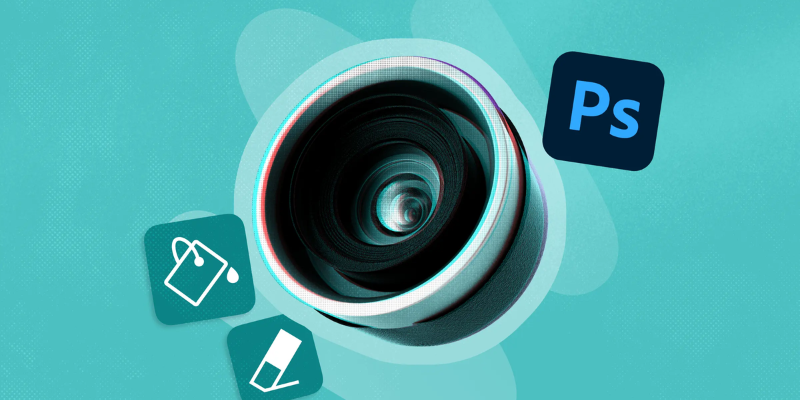Creating compelling material may not necessarily necessitate advanced video editing software. Photoshop, well-known for its picture editing capabilities, also lets you create and export short films. Many artists are shocked to realize that Photoshop includes a video timeline function that allows them to mix visuals, text, animations, and audio into a single seamless presentation. Photoshop simplifies the process of creating social media material, lessons, and personal projects.
What is the best part? You don’t need hours to study or apply it. With the appropriate strategy, you can make a finished video in just seven minutes. This article will bring you through the process step by step. It will also demonstrate how to prepare your project. This gives you the option to use Photoshop’s features effectively and save time. You’ll realize that video making isn’t just for specialists. But it’s a skill that anyone can learn with some practice and ingenuity. Advance your career opportunities with Photoshop training at FITA Academy through expert mentorship, practical projects, and industry-relevant skills that prepare you for creative success and professional growth.
Make Photoshop Workspace
First process in this Photoshop is to begin creating your film, set up your Photoshop workspace. Launch Photoshop and create a new project with the desired resolution. Your need for dimensions for your video should be specific. If you want to create social media content, the optimal formats are square (1080×1080) or vertical (1080×1920). Next, select Window > Timeline to open the Timeline panel. This panel converts Photoshop into a movie editing environment that allows you to organize layers consecutively.
Setting up your workstation saves time because you won’t have to alter essential settings later. Make sure your layers are appropriately labeled, as organization is essential in video projects. A tidy and organized workspace allows you to easily find what you need without confusion. Consider this step to be the set-up for a performance. When you start preparation in a smoother way the better your outcome. This phase is sometimes forgotten, but it is the cornerstone of a quick and efficient process.
Start Media Files imported
In this process the need for accuracy is greater. As your video requires visuals and graphics with brief video snippets. Which makes the video come to life. In Photoshop, you can easily import media by dragging files into your document or selecting File > Place Embedded. This lets you position and scale your elements before adding them to the timeline. Preparing your files ahead of time will help you save time while developing a brief tutorial or promotional content. High-resolution photographs appear sharper, but keep file sizes manageable to prevent slowing down Photoshop.
Once imported, arrange your files in layers. Each layer represents an element of your video, such as a photo, image, or text. Organizing your media early allows you to concentrate on creative editing rather than digging through folders afterward. Importing efficiently paves the way for faster assembly, allowing you to stay under your seven-minute time limit while preserving quality and clarity. Through Photoshop courses at a Training Institute in Chennai, students gain practical experience, creative skills, and industry exposure that greatly enhance their career growth.
Timeline Panel
The Timeline window is where your project changes from static photos to moving video. Change from “Create Frame Animation” to “Create Video Timeline” to gain more control over your clips. Layers can be arranged, their durations adjusted, and even overlapped to create smoother transitions. Each layer has its own timeline, making editing easier. Drag your layers around the timeline to determine when they will appear or disappear in your film.
To create a rapid transition between two photos, simply shorten the time of one layer. Do you want a smoother flow? Extend the overlap to achieve a fading effect. The Timeline panel may seem intimidating at first, but with practice, it becomes straightforward. Efficient use of this tool is essential for producing a finished video rapidly. By making some changes your content looks professional without using advanced editing software.
Be clear in the text
A strong video frequently mixes graphics and text for improved communication. Photoshop streamlines the procedure. Use the Text Tool (T) to add titles, captions, and essential messages to your project. Place them appropriately so that they do not obscure vital views. In the Timeline panel, text layers operate similarly to image layers, allowing you to choose when they appear and disappear.
If you wish to highlight a product name, animate the text such that it fades in and out. You can also change the fonts, colors, and effects to reflect your brand or style. Well-placed text enhances your video’s impact by directing the viewer’s attention and making the content apparent. Text manipulation is one of Photoshop’s specialties, so it feels natural to use it here. This process takes only a minute or two but provides tremendous value to your final film. Join a Photoshop Course in Chennai to master creative design and image editing skills that elevate your career opportunities.
Make Basic Animations
Animations make your movie more entertaining without requiring any additional equipment. Photoshop allows you to animate objects directly in the Timeline panel. Select a layer, then click the stopwatch icon to establish keyframes for characteristics such as position, opacity, and scale. For example, you can slide an image over the screen or make a title appear gradually. Animations bring vitality to your video, making it feel less static and more engaging. Keep movements basic, as too many effects can detract from your message.
Smooth transitions such as fading, sliding, or zooming are ideal for rapid projects. Since your goal is efficiency, prepare which elements to animate ahead of time to prevent spending time experimenting. Professional effects can be achieved without the need for more complex software by using Photoshop’s built-in animation features. With practice, these animations take seconds to put up while significantly improving the quality of your final work.
For Professional Audio Touch
A video without sound feels incomplete. Photoshop allows you to add audio tracks to your projects, making them more interesting. To import an audio file, go to the Timeline panel and then click the music note icon. Choose a background track or narration that is appropriate for the tone of your film. Adjust the audio length to match the video duration, and remove any extraneous bits.
If your video is brief, choose lively or minimalist music that complement rather than overpower the graphics. Good audio provides your product a professional appearance, which makes it more desirable to viewers. Although Photoshop’s audio capabilities are simple, they are adequate for short, professional videos. Visuals combined with the correct soundtrack may elevate a simple slideshow to a remarkable experience. This process takes about a minute, but it adds a level of professionalism to your video, making it stand out in social media feeds or online presentations.
Make Video export Correctly
The video has been polished; it’s time to export. Go to File > Export > Render Video and select your options. For the most part, the H.264 format works effectively, resulting in high-quality videos with smaller file sizes. To avoid losing track of your project, name it explicitly and select the appropriate folder. Select the resolution that best fits your platform: 1080p for YouTube or social media, 720p for speedier uploads.
Rendering time is determined by the complexity of your project and your computer’s speed and small films typically process rapidly. Saving appropriately guarantees that your video may be shared across several platforms without losing quality. Do not forget to save your PSD file in case you want to make changes later. Proper exporting is the final step in transforming your creative work into a usable video. With practice, you’ll find that this method is fast, efficient, and extremely gratifying.
Final Thoughts
In this blog, we have seen what are the features of Photoshop. Creating a film with Photoshop may seem strange, but it is surprisingly efficient if you understand the technique. In seven minutes, you can create a finished project by setting up your workspace, importing media, using the Timeline panel, and adding elements such as text, animations, and audio. Exporting completes the process, resulting in a shareable video appropriate for social media, instructional, and marketing. What makes this method effective is its simplicity; there is no need for complex tools when Photoshop already has what you require.
For content creators working under tight deadlines, this strategy saves time without losing quality. It also provides opportunities for beginners who want to explore with video without investing in complex tools. With some practice, making videos in Photoshop can become second nature. So, open Photoshop, follow these steps, and start creating short, creative videos that will impress your audience and elevate your content strategy.


